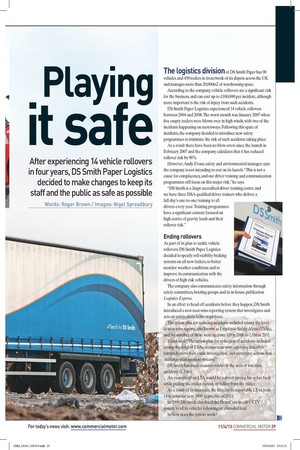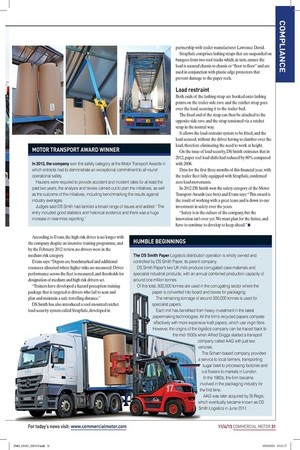Playing it safe After experiencing 14 vehicle rollovers in four
Page 20

Page 21

Page 22

If you've noticed an error in this article please click here to report it so we can fix it.
years, DS Smith Paper Logistics decided to make changes to keep its staff and the public as safe as possible Words: Roger Brown / Images: Niget spreadbury The logistics division of DS Smith Paper has 90 vehicles and 450 trailers in its network of six depots across the UK and manages more than 20,000m2 of warehousing space.
According to the company, vehicle rollovers are a significant risk for the business, and can cost up to £100,000 per incident, although more important is the risk of injury from such accidents.
DS Smith Paper Logistics experienced 14 vehicle rollovers between 2004 and 2008. The worst month was January 2007 when five empty trailers were blown over in high winds, with two of the incidents happening on motorways. Following this spate of incidents, the company decided to introduce new safety programmes to minimise the risk of such accidents taking place.
As a result there have been no blow-overs since the launch in February 2007 and the company calculates that it has reduced rollover risk by 90% However, Andy Evans, safety and environmental manager, says the company is not intending to rest on its laurels. "This is not a cause for complacency, and our driver training and communication programmes still focus on this major risk," he says.
"DS Smith is a Jaupt-accredited driver training centre and we have three DSA qualified driver trainers who deliver a full day's one-to-one training to all drivers every year Training programmes have a significant content focused on high-centre of gravity loads and their rollover risk."
Ending rollovers As part of its plan to tackle vehicle rollovers, DS Smith Paper Logistics decided to specify roll-stability braking systems on all new trailers, to better monitor weather conditions and to improve its communication with the drivers of high-risk vehicles.
The company also communicates safety information through safety committees, briefing groups and its in-house publication Logistics Express.
In an effort to head off accidents before they happen, DS Smith introduced a new near-miss reporting system that investigates and acts on safety alerts from employees.
The action plan for reducing accidents included raising the level of near miss reports, also known as Employee Safety Alerts (ESAs), and the number of these went up from 319 in 2008 to 1,516 in 2011.
Evans says: "The action plan for reduction of accidents included raising the level of ESAs, serious near-miss reporting linked to comprehensive root cause investigation, and corrective actions that challenge management systems."
DS Smith has made massive strides in the area of lost-time accidents (LTAs).
An example of an LTA would be a driver jarring his or her back while pulling the trailer curtain, or falling from the trailer.
As a result of its measures, the firm cut its reportable LTAs from 14 in calendar year 2008 to just two in 2011 In 2009 DS Smith also fitted the DriveCam in-cab CCTV system to all its vehicles following an extended trial. So how does the system work? With DriveCam, two cameras face the driver and the forward cab view. They only record a video clip when triggered by harsh braking, a collision or fast cornering.
The system requires drivers to maintain a two-second gap between their truck and the vehicle in front. This enables trainers to identify risky behaviour, such as harsh braking, driving too close to the vehicle in front and thus breaking the two-second rule, or approaching roundabouts and intersections too quickly.
It also picks up on behavioural issues such as mobile phone abuse, eating and drinking while the vehicle is in motion, seatbelt misuse and, most importantly, any fatigue-related incident.
Clips are downloaded as vehicles return to the depot and uploaded to DriveCam at San Diego, California, overnight to be viewed and scored. Driver coaches and managers study the film clip which shows the eight seconds prior to the trigger point and up to the four seconds after it.
Two-second safety gap Evans says the effect of drivers maintaining the twosecond gap means a significant reduction in collision risk.
He adds: "Drivers quickly understand that maintaining this gap, even when other vehicles constantly encroach, is the only way to avoid setting the camera off."
In the five years immediately before fitting DriveCam, DS Smith experienced 14 rollover incidents involving its vehicles. However, there has been only one rollover in the three years since the system was fitted — in the middle of 2009 when it had only been in operation for five months.
In 2011, DS Smith also introduced a monthly driver risk review system designed to identify problems and target appropriate training. At the outset of the review, DS Smith had eight drivers in the medium risk category and one in the high risk. According to Evans, the high risk driver is no longer with the company despite an intensive training programme, and by the February 2012 review, no drivers were in the medium risk category.
Evans says: "Depots are benchmarked and additional resources allocated where higher risks are measured. Driver performance across the fleet is measured, and thresholds for designation of medium and high risk drivers set.
"Trainers have developed a hazard perception training package that is targeted at drivers who fail to scan and plan and maintain a safe travelling distance."
DS Smith has also introduced a roof-mounted ratchet load security system called StrapSafe, developed in partnership with trailer manufacturer Lawrence David.
StrapSafe comprises lashing straps that are suspended on bungees from two roof tracks which, in turn, ensure the load is secured chassis to chassis or "floor to floor and are used in conjunction with plastic edge protectors that prevent damage to the paper reels.
Load restraint Both ends of the lashing strap are hooked onto lashing points on the trailer side rave and the ratchet strap goes over the load, securing it to the trailer bed.
The fixed end of the strap can then be attached to the opposite side rave and the strap tensioned via a ratchet strap in the normal way.
It allows the load-restraint system to be fitted, and the load secured, without the driver having to clamber over the load, therefore eliminating the need to work at height.
On the issue of load security, DS Smith estimates that in 2012, paper reel load shifts had reduced by 80% compared with 2008.
Data for the first three months of this financial year, with the trailer fleet fully equipped with StrapSafe, confirmed zero load movements.
In 2012 DS Smith won the safety category of the Motor Transport Awards (see box) and Evans says: "This award is the result of working with a great team and is down to our investment in safety over the years.
"Safety is in the culture of the company, but the innovation isn't over yet. We must plan for the future, and have to continue to develop to keep ahead." • SETTING THE STANDARD In June 2011 Zurich Insurance published its benchmark external audit and analysis of DS Smith fleet systems which showed an overall audit score of 89% against the Zurich national average of 68%.
In 2011, DS Smith also decided to benchmark its Safety Management System against the OHSAS 18001 standard.
Accreditation using Det Norske Veritas (DNV) was achieved in December 2011 following a short process that included gap analysis and minimal changes to the existing management system.
DNV said in its initial audit that DS Smith had achieved "exceptionally high performance".
DS Smith safety and environmental manager Evans says: "External audit and analysis is important to be able to benchmark the DS Smith systems against the transport industry for fleet systems performance, and against industry generally for the performance of safety management systems." MOTOR TRANSPORT AWARD WINNER In 2012, the company won the safety category at the Motor Transport Awards in which entrants had to demonstrate an exceptional commitment to all-round operational safety.
Hauliers were required to provide accident and incident rates for at least the past two years, the analysis and review carried out to plan the initiatives, as well as the outcome of the initiatives, including benchmarking the results against industry averages.
Judges said DS Smith had tackled a broad range of issues and added: "The entry included good statistics and historical evidence and there was a huge increase in near-miss reporting."
HUMBLE BEGINNINGS The DS Smith Paper Logistics distribution operation is wholly owned and controlled by DS Smith Paper, its parent company.
DS Smith Paper's two UK mills produce corrugated case materials and specialist industrial products, with an annual combined production capacity of around one million tonnes.
Of this total, 800,000 tonnes are used in the corrugating sector where the paper is converted into board and boxes for packaging.
The remaining tonnage of around 300,000 tonnes is used for specialist papers.
Each mill has benefited from heavy investment in the latest papermaking technologies. All the firm's recycled papers compete effectively with more expensive kraft papers, which use virgin fibre. However, the origins of the logistics company can be traced back to the mid-1930s when Alfred Griggs started a transport company called AAG with just two vehicles.
The Soham-based company provided a service to local farmers, transporting sugar beet to processing factories and cut flowers to markets in London. In the 1960s, the firm became involved in the packaging industry for the first time.
MG was later acquired by St Regis, which eventually became known as DS Smith Logistics in June 2011.







































